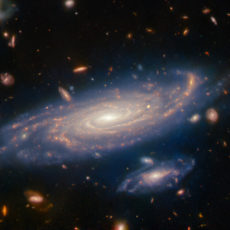
NASA’s James Webb Space Telescope celebrates its 2nd anniversary with this stunning image of interacting galaxies Arp 124. Its NIRCam (Near-Infrared Camera) and MIRI (Mid-Infrared Instrument) were used to show the distorted spiral galaxy at center, the Penguin, as well as the compact elliptical at left, the Egg, locked in an active embrace.
Webb’s image shows that their interaction is marked by a glow of scattered stars represented in blue. The galaxies, known jointly as Arp 142, made their first pass by one another between 25 and 75 million years ago, resulting in fireworks, or new star formation, in the Penguin. These two galaxies are roughly the same mass, which is why one hasn’t devoured the other.
- COMPUTERIZED STAR LOCATING TELESCOPE: The Celestron NexStar 130SLT is a computerized telescope that offers a database of more than 4,000 stars,...
- COMPACT AND PORTABLE: This telescope for adults and kids to be used together is ideal for weekend camping trips or excursions to dark sky sites. Its...
- NEWTONIAN REFLECTOR OPTICAL DESIGN: The NexStar 130SLT is the largest in the SLT family. The 130mm aperture gathers enough light to see our Solar...

In just two years, Webb has transformed our view of the universe, enabling the kind of world-class science that drove NASA to make this mission a reality. Webb is providing insights into longstanding mysteries about the early universe and ushering in a new era of studying distant worlds, while returning images that inspire people around the world and posing exciting new questions to answer. It has never been more possible to explore every facet of the universe,” said Mark Clampin, director of the Astrophysics Division at NASA Headquarters in Washington.













